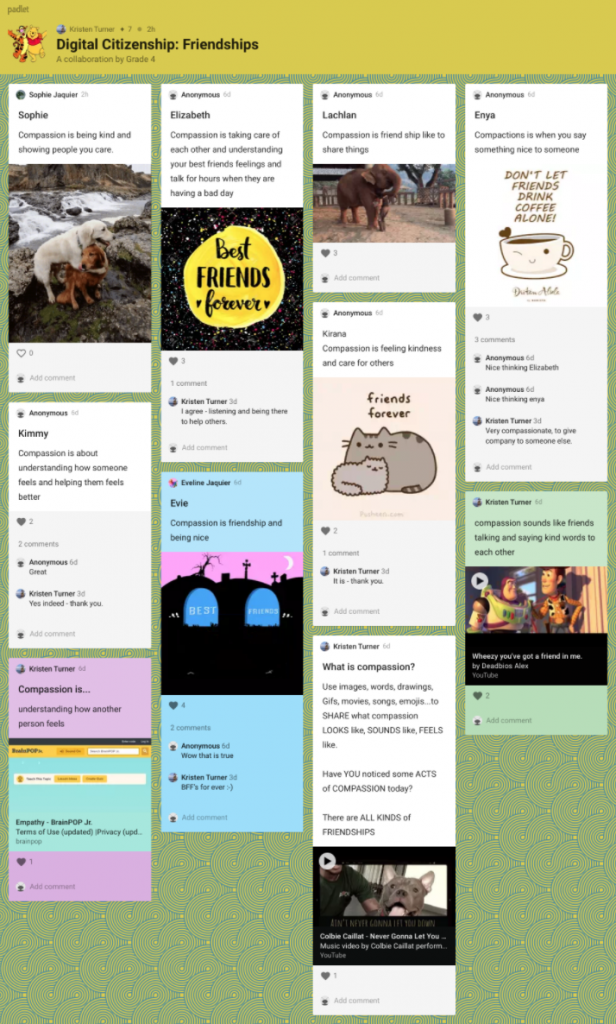Primary eNews – November 13, 2020
A Novel Study in Grade 4
Grade 4 has been sharing the novel, The Hundred Dresses by Eleanor Estes as a provocation for discussions on friendships, empathy, and being globally minded.

In our Distance Learning classroom, this sometimes includes modeled reading where the students listen to the text being read aloud by me. In these read aloud sessions, I aim to demonstrate skilled reading and comprehension behaviors like fluency, pacing and thinking aloud, making predictions, and making connections to my own experiences.
At other times, students read or listen to recordings of the text, with a specific purpose: to identify parts of speech, finding clues in the text to give meaning to unfamiliar words, or to answer questions.
Both modes of the shared reading experience, develop students as readers, and promote enjoyment for reading.
We all love listening to a good story! It is a great way to unplug and share some time with others as well.
The Hundred Dresses by Eleanor Estes is a story of compassion and connects nicely to our first two units of inquiry. Grade 4 started our novel discussions with a collaborative activity in Padlet. They were asked to share their own ideas on what compassion is before reading and responding (in a positive way) to each other.
This common understanding has become our springboard for discussions following reading each chapter.
We are up to Chapter 6 and have just discovered the link between the text and the novel title. We are waiting with enthusiasm to find out the ending connecting this back to ourselves as globally minded learners.
Be sure to ask your child about The Hundred Dresses.
Counseling
I run Positive Discipline for parents and hope to offer this soon to all of you. In this parenting way, the big idea is that you learn the importance of being kind and firm, not permissive, authoritarian, or neglectful. One of the tools that parents tell me truly changes how their family engages is having weekly family meetings. Family meetings are a sacred family time that does not get altered due to work, homework, etc. Even if one family member is out of the country, that member shows commitment and joins (virtually). Family meetings teach children about social and life skills. They give everyone in the family a voice.
How do you choose the day and time? Decide when you usually get together, like after a Saturday breakfast or Wednesday night dinner. Have a whiteboard or paper on the refrigerator where family members can write issues to solve during the family meeting. Ex- We fight every morning before school, and it starts my day off terribly.
What’s the format?
- Compliments and appreciations- Everyone should share. If you have a real talker in the family, you can use a timer and pass around an item, like a pet rock, where only the person with the pet rock can talk.
- Evaluation of past solutions– Is the solution we are trying from a past problem working for us? Ex- I know we agreed that I would go to my calming space when I’m upset, but it’s not working. What else can I try?
- Agenda items – Each person can choose to:
- Share feelings (It’s helpful to have a feelings chart.)
- Invite a discussion (Share an exciting fact, current event, or something that happened at work/school.)
- Brainstorm for solutions (Together, the family selects a problem from their list, and every one offers possible solutions. The family decides on a solution to try for a set time.)
- Calendar events, meal planning- This is a time to get the next week planned and divide the tasks. Children naturally like helping, but we teach them not to when we discourage them after they try. Let them be involved in helping around the house.
- Fun activity and dessert- The dessert is optional, but you should end with a fun board or card game, take a walk together, or do something that everyone enjoys.
Most importantly, if you tell your children you are making this a committed family time each week, devices should not be visible. Family meetings are more than having a meal together. They help children learn to present their issues, problem solve, give input for the upcoming week, and continue labeling their feelings. Family meetings build connections and empathy.

